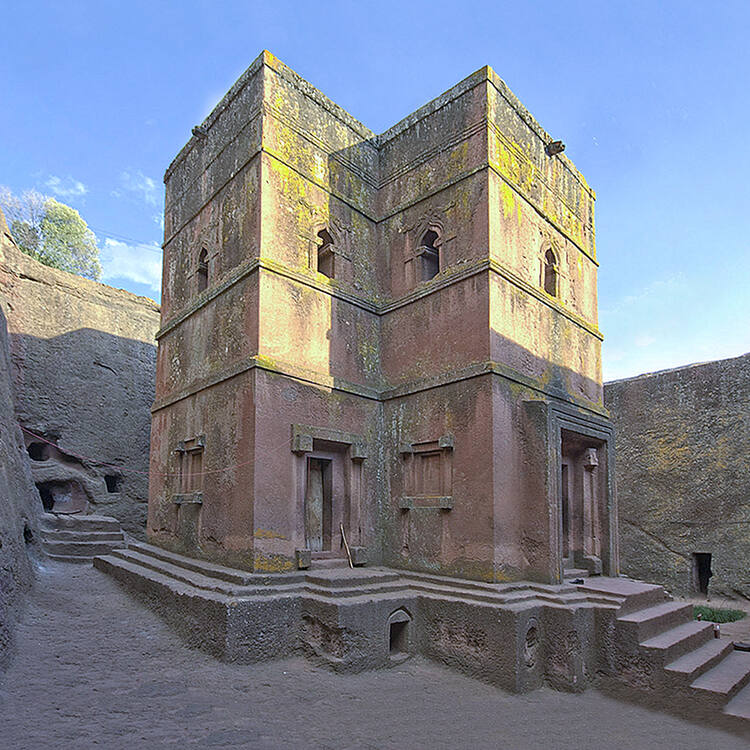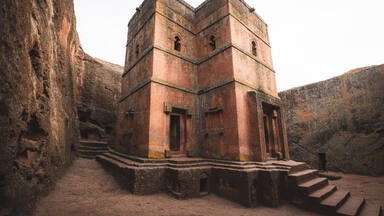Rock-Hewn Churches, Lalibela
Rock-Hewn Churches, Lalibela
The 11 medieval monolithic cave churches of this 13th-century 'New Jerusalem' are situated in a mountainous region in the heart of Ethiopia near a traditional village with circular-shaped dwellings. Lalibela is a high place of Ethiopian Christianity, still today a place of pilmigrage and devotion.
Description is available under license CC-BY-SA IGO 3.0
Églises creusées dans le roc de Lalibela
Au cœur de l'Éthiopie, dans une région montagneuse, les onze églises monolithes médiévales de cette « nouvelle Jérusalem » du XIIIe siècle ont été creusées et taillées à même le roc près d'un village traditionnel aux maisons rondes. Lalibela est un haut lieu du christianisme éthiopien, lieu de pèlerinage et de dévotions.
Description is available under license CC-BY-SA IGO 3.0
الكنائس المحفورة في صخر لاليبلا
في عمق إثيوبيا، في منطقة جبليّة، أخرجت الصخور من رحمها نحتاً وصقلاً كنائس القرون الوسطى،أوشاليم جديدة" للقرن الثالث عشر، على مقربةٍ من قريةٍ تقليديّةٍ بمنازلها المستديرة. ولاليبلا هي مكان مرموق بالنسبة إلى المسيحية في أثيوبيا وأرض عبادة وحجيج.
source: UNESCO/CPE
Description is available under license CC-BY-SA IGO 3.0
拉利贝拉岩石教堂
这是 13世纪“新耶路撒冷”的11座中世纪的原始窑洞教堂,坐落于埃塞俄比亚中心地带的山区,附近是环形住宅构成的传统村落。拉利贝拉是埃塞俄比亚基督徒眼中的圣地,至今仍有虔诚的信徒前去朝圣。
source: UNESCO/CPE
Description is available under license CC-BY-SA IGO 3.0
Скальные церкви в Лалибэле
11 средневековых вырезанных в скалах пещерных церквей этого "Нового Иерусалима" XIII в. находятся в горном районе в центре Эфиопии, неподалеку от деревни с традиционными, округлой формы, хижинами. Лалибэла – это вершина эфиопского христианства, являющаяся ныне местом паломничества и поклонения.
source: UNESCO/CPE
Description is available under license CC-BY-SA IGO 3.0
Iglesias excavadas en la roca de Lalibela
Situadas en una región montañosa del corazón de Etiopía, en las proximidades de una aldea tradicional de casas redondas, las once iglesias medievales de esta “Nueva Jerusalén” del siglo XIII fueron excavadas y esculpidas en la roca. Lugar sagrado de la cristiandad etíope, Lalibela sigue siendo hoy en día un centro de devoción y peregrinación.
source: UNESCO/CPE
Description is available under license CC-BY-SA IGO 3.0
ラリベラの岩窟教会群
標高2600mのラリベラにあるキリスト教(アビシニア正教)教会群。13世紀初め、サグウェ朝のラリベラ王が第二のエルサレムをつくる目的で、ヨルダン川の両岸に岩をくりぬいた二つの教会群をつくった。一つはエマヌエル教会、ルクリウス教会など、他方は対岸のゴルゴダ・ミカエル教会、聖マリア教会などで、現在も信仰生活の拠点となっている。source: NFUAJ
Uit de rots gehouwen kerken, Lalibela
In een bergachtig gebied in het hart van Ethiopië – ongeveer 645 kilometer van Addis Abeba – werden elf middeleeuwse monolithische kerken uitgehouwen uit de rotsen. Ze werden gebouwd dankzij koning Lalibela die in de 12e eeuw een ‘Nieuw Jeruzalem’ wilde bouwen, nadat islamitische veroveringen christelijke bedevaarten naar het Heilige Land stopten. De kerken zijn gehouwen uit monolithische blokken, die vervolgens uitgebeiteld werden tot zich deuren, ramen, kolommen,vloeren en daken vormden. Het gigantische werk werd verder aangevuld met een uitgebreid stelsel van sloten, greppels en ceremoniële passages. Sommige passages hebben openingen naar kluizenaarsgrotten en catacomben.
Source: unesco.nl
Outstanding Universal Value
Brief synthesis
In a mountainous region in the heart of Ethiopia, some 645 km from Addis Ababa, eleven medieval monolithic churches were carved out of rock. Their building is attributed to King Lalibela who set out to construct in the 12th century a ‘New Jerusalem’, after Muslim conquests halted Christian pilgrimages to the holy Land. Lalibela flourished after the decline of the Aksum Empire.
There are two main groups of churches – to the north of the river Jordan: Biete Medhani Alem (House of the Saviour of the World), Biete Mariam (House of Mary), Biete Maskal (House of the Cross), Biete Denagel (House of Virgins), Biete Golgotha Mikael (House of Golgotha Mikael); and to the south of the river, Biete Amanuel (House of Emmanuel), Biete Qeddus Mercoreus (House of St. Mercoreos), Biete Abba Libanos (House of Abbot Libanos), Biete Gabriel Raphael (House of Gabriel Raphael), and Biete Lehem (House of Holy Bread). The eleventh church, Biete Ghiorgis (House of St. George), is isolated from the others, but connected by a system of trenches.
The churches were not constructed in a traditional way but rather were hewn from the living rock of monolithic blocks. These blocks were further chiselled out, forming doors, windows, columns, various floors, roofs etc. This gigantic work was further completed with an extensive system of drainage ditches, trenches and ceremonial passages, some with openings to hermit caves and catacombs.
Biete Medhani Alem, with its five aisles, is believed to be the largest monolithic church in the world, while Biete Ghiorgis has a remarkable cruciform plan. Most were probably used as churches from the outset, but Biete Mercoreos and Biete Gabriel Rafael may formerly have been royal residences. Several of the interiors are decorated with mural paintings.
Near the churches, the village of Lalibela has two storey round houses, constructed of local red stone, and known as the Lasta Tukuls. These exceptional churches have been the focus of pilgrimage for Coptic Christians since the 12th century.
Criterion (i): All the eleven churches represent a unique artistic achievement, in their execution, size and the variety and boldness of their form.
Criterion (ii): The King of Lalibela set out to build a symbol of the holy land, when pilgrimages to it were rendered impossible by the historical situation. In the Church of Biet Golgotha, are replicas of the tomb of Christ, and of Adam, and the crib of the Nativity. The holy city of Lalibela became a substitute for the holy places of Jerusalem and Bethlehem, and as such has had considerable influence on Ethiopian Christianity.
Criterion (iii): The whole of Lalibela offers an exceptional testimony to the medieval and post-medieval civilization of Ethiopia, including, next to the eleven churches, the extensive remains of traditional, two storey circular village houses with interior staircases and thatched roofs.
Integrity
The drainage ditches were filled up with earth for several centuries, before being cleared in the 20th century, and have been disrupted by seismic activity. This has resulted in a severe degradation of the monuments from water damage, and most of them are now considered to be in a critical condition.
Structural problems have been identified in Biet Amanuel where an imminent risk of collapse is possible, and other locations need to be monitored. Serious degradation of the paintings inside the churches has occurred over the last thirty years. Sculptures and bas-reliefs (such as at the entrance of Biet Mariam) have also been severely damaged, and their original features are hardly recognisable. All of this threatens the integrity of the property.
Temporary light-weight shelters have now been installed over some churches and these, while offering protection, impact on visual integrity.
Other threats include encroachment on the environment of the churches by new public and private construction, housing associated with the traditional village adjacent to the property, and from the infrastructure of tourism.
Authenticity
The Rock-Hewn Churches of Lalibela are still preserved in their natural settings. The association of the rock-hewn churches and the traditional vernacular circular houses, in the surrounding area, still demonstrate evidences of the ancient village layout. The original function of the site as a pilgrimage place still persists and provides evidence of the continuity of social practices. The intangible heritages associated with church practices are still preserved.
Protection and management requirements
For centuries, the Church and State have been jointly responsible for the holy site of Lalibela. Home to a large community of priests and monks, it is a living site which draws many pilgrims to celebrate the great feasts of the Ethiopian Christian calendar. This active and energetic perspective is central to the management of the site.
No special legal framework is provided to protect the Rock-Hewn Churches except the general law, Proclamation No. 209/2000, which has also established the institution in charge, the Authority for Research and Conservation of Cultural Heritage (ARCCH). With the Ethiopian Church as a partner, the ARCCH has a representative in Lalibela but a principle difficulty has been the harmonization of the different projects and effective coordination between the partners.
The property is administered under the regional and the Lasta district culture and tourism office. To prevent the property from the impact of development, a draft proclamation has been prepared but this is not yet ratified. A management plan has not yet been established. A four year Conservation Plan was established in 2006 but this has yet to be fully implemented.
The boundary for the property has not yet been clearly delineated and a buffer zone has not yet been provided.
There is a need for stronger planning controls for the setting of the churches that address housing, land-use tourism and for a management plan to be developed that integrates the Conservation action plan, and addresses the overall sustainable development of the area, with the involvement of the local population.

 View photos from OUR PLACE the World Heritage collection
View photos from OUR PLACE the World Heritage collection



